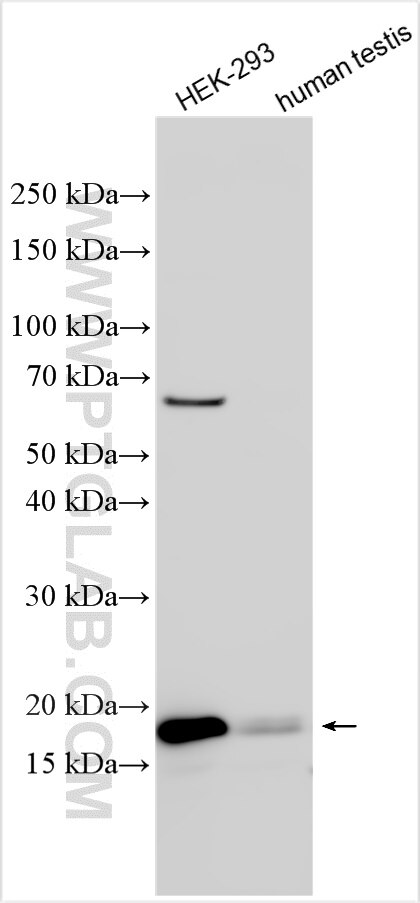Tested Applications
| Positive WB detected in | HEK-293 cells, human testis tissue |
Recommended dilution
| Application | Dilution |
|---|---|
| Western Blot (WB) | WB : 1:500-1:2000 |
| It is recommended that this reagent should be titrated in each testing system to obtain optimal results. | |
| Sample-dependent, Check data in validation data gallery. | |
Product Information
26054-1-AP targets TSEN15 in WB, ELISA applications and shows reactivity with human samples.
| Tested Reactivity | human |
| Host / Isotype | Rabbit / IgG |
| Class | Polyclonal |
| Type | Antibody |
| Immunogen |
CatNo: Ag22082 Product name: Recombinant human TSEN15 protein Source: e coli.-derived, PET30a Tag: 6*His Domain: 1-171 aa of BC022030 Sequence: MEERGDSEPTPGCSGLGPGGVRGFGDGGGAPSWAPEDAWMGTHPKYLEMMELDIGDATQVYVAFLVYLDLMESKSWHEVNCVGLPELQLICLVGTEIEGEGLQTVVPTPITASLSHNRIREILKASRKLQGDPDLPMSFTLAIVESDSTIVYYKLTDGFMLPDPQNISLRR Predict reactive species |
| Full Name | tRNA splicing endonuclease 15 homolog (S. cerevisiae) |
| Calculated Molecular Weight | 171 aa, 19 kDa |
| Observed Molecular Weight | 18-20 kDa |
| GenBank Accession Number | BC022030 |
| Gene Symbol | TSEN15 |
| Gene ID (NCBI) | 116461 |
| RRID | AB_3669520 |
| Conjugate | Unconjugated |
| Form | Liquid |
| Purification Method | Antigen affinity purification |
| UNIPROT ID | Q8WW01 |
| Storage Buffer | PBS with 0.02% sodium azide and 50% glycerol, pH 7.3. |
| Storage Conditions | Store at -20°C. Stable for one year after shipment. Aliquoting is unnecessary for -20oC storage. 20ul sizes contain 0.1% BSA. |
Background Information
TSEN15 is the non-catalytic subunit of the tRNA-splicing endonuclease complex, which is a complex responsible for identification and cleavage of the splice sites in pre-tRNA. It cleaves pre-tRNA at the 5' and 3' splice sites to release the intron. The products are an intron and two tRNA half-molecules bearing 2',3' cyclic phosphate and 5'-OH termini (PMID: 15109492, 27392077).
Protocols
| Product Specific Protocols | |
|---|---|
| WB protocol for TSEN15 antibody 26054-1-AP | Download protocol |
| Standard Protocols | |
|---|---|
| Click here to view our Standard Protocols |




